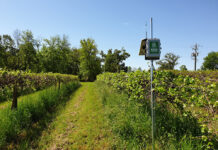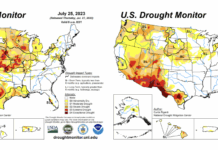The 2017-2018 United States (U.S.) citrus crop was valued at 3.28 billion dollars with California’s citrus production accounting for 59 percent of the overall U.S. production. Much of California’s bearing acreage is devoted to orange production, however other citrus varieties of tangerine, mandarin, lemon and grapefruit are grown throughout the state. As the California citrus industry contributes to over half of the total U.S. citrus production, the identification and management of new disease threats is crucial.
Colletotrichum, a Globally Distributed Fungus
Colletotrichum constitutes a large genus of fungi which are known for having diverse ecological roles ranging from endophytes, fungi living within plant tissues and causing no known problems, to plant pathogens that can kill entire plants or portions of the plant. Colletotrichum includes some important fungal pathogens of numerous plant hosts including native and agricultural plant species occurring in tropical and subtropical regions in the world. Colletotrichum is well-known for causing various anthracnose diseases on many plants, with general anthracnose symptoms including necrotic lesions on various plant parts including stems, leaves, flowers and fruits. Although Colletotrichum is primarily described as causing anthracnose diseases, other diseases such as rots caused by Colletotrichum spp. have been documented.
Currently, over 100 species of Colletotrichum have been described and recent phylogenetic studies (which show the relationship among organisms) based on the analysis of DNA has found that at least 71 unique phylogenetic species exist within three well known ‘species’ of Colletotrichum based on traditional morphology; C. gloeosporioides, C. acutatum, and C. boninense. The large species diversity within the Colletotrichum genus highlights the importance of DNA phylogenies to accurately identify species. With respect to citrus, two species of Colletotrichum, C. gloeosporioides (Penz.) Penz. & Sacc. and C. acutatum J.H. Simmonds, have been associated with anthracnose diseases of citrus. These anthracnose diseases, which include post-harvest anthracnose, postbloom fruit drop (PFD), and key lime anthracnose (KLA) are of great economic importance as postharvest diseases. However, recent evidence is suggesting that additional species of Colletotrichum previously unknown from citrus are causing diseases of citrus globally, particularly from the C. boninense species complex.
Colletotrichum karstii You L. Yang, Zuo Y. Liu, K.D. Hyde & L. Cai (C. boninense species complex) has been increasingly reported from anthracnose symptoms of citrus worldwide and is often found to occur in association with other Colletotrichum spp., particularly C. gloeosporioides which generally predominates within citrus hosts. C. karstii has been increasingly reported from anthracnose diseases of other crops including avocado, mango, and persimmon and is considered the most common and widely distributed species of the C. boninense species complex. Although C. karstii has been reported from citrus in China, Italy, and Portugal, in the United States C. karstii has only been reported from other host species.
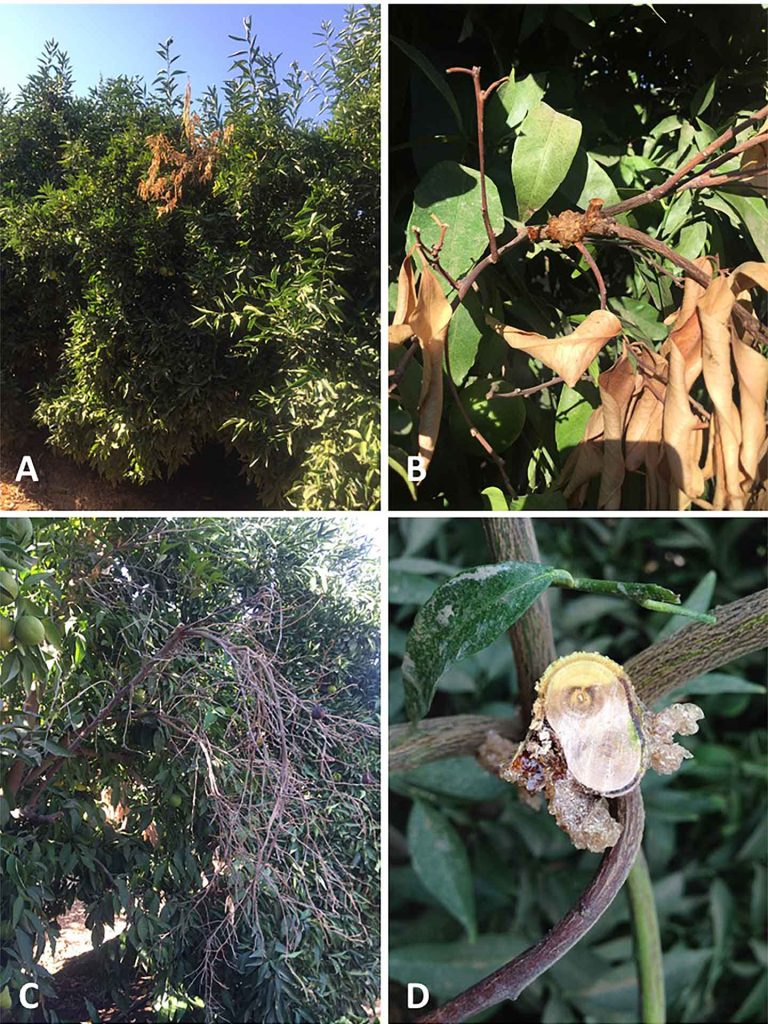
Colletotrichum Symptomology
Recently, unusual disease symptoms associated with Colletotrichum spp. have been observed frequently in various citrus orchards in the San Joaquin Valley of California (Eskalen, per ob). Symptoms include leaf chlorosis, twig and shoot dieback, crown thinning, wood cankers in branches and in some cases death of young plants (Figure 1). Isolations from diseased tissues yielded typical Colletotrichum species based on colony morphology but slight differences also suggested that more than one species may be present. Historically, C. gloeosporioides sensu stricto has been the only species associated with anthracnose diseases of citrus in California.
C. karstii, a ‘New’ Species Associated With Citrus in California
Recent work by researchers at the University of California have now identified C. karstii as a new pathogen of citrus causing twig and shoot dieback with or without gumming and occasionally branch dieback and wood canker in the Central Valley of California. Pathogenicity tests on clementine mandarin also confirmed that C. karstii is a more aggressive pathogen of citrus in California compared to C. gloeosporioides based on in planta experiments (Figure 2). Based on a survey of samples collected throughout the Central Valley, this same research also found that both species are commonly isolated from symptomatic tissues and were often found co-infecting the symptomatic samples. However, the researchers also never found other known wood canker pathogen species of citrus within the Botryosphaeriaceae and Diatrypaceae from samples in which both Colletotrichum species were isolated. Unlike anthracnose which can cause twig dieback and is associated with C. gloeosporioides, this disease is associated with two species of Colletotrichum and is not limited to twig dieback alone but is also associated with shoot dieback and in some cases, woody cankers. Taken together, this confirms C. karstii as a new pathogen of citrus in California causing a disease distinct from anthracnose which is caused by C. gloeosporioides.
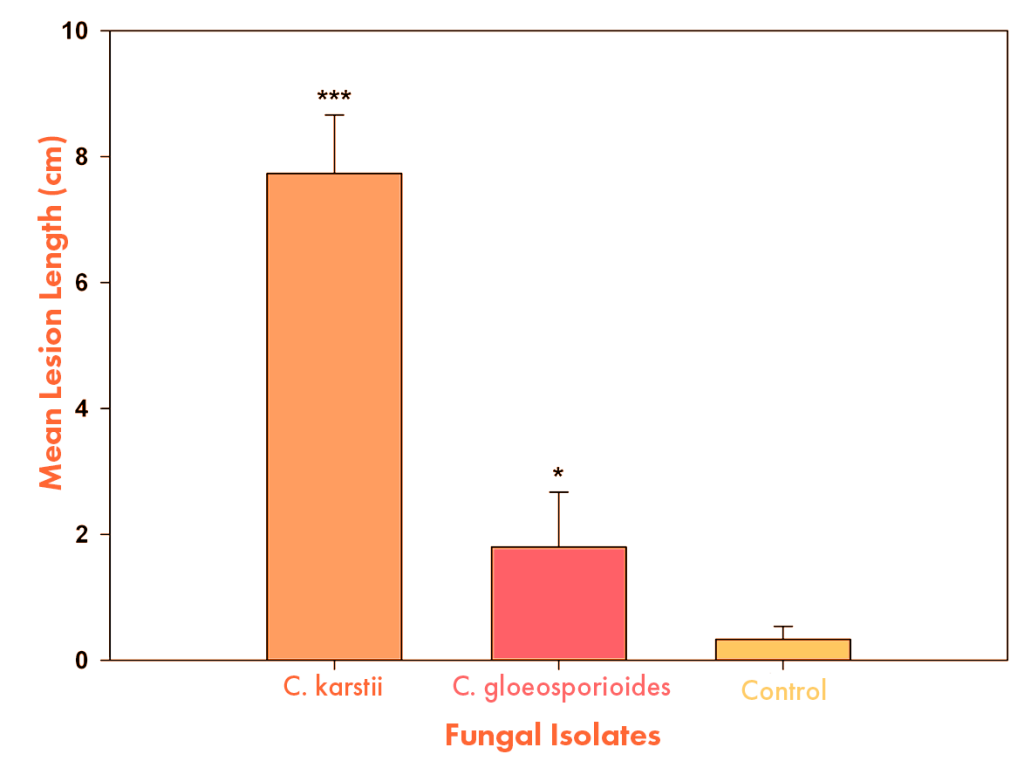
The association of C. karstii with citrus twig and shoot dieback in California represents a significant finding since C. karstii appears now to be a new pathogen of citrus in the United States. Anthracnose disease of citrus has mainly been attributed to C. gloeosporioides and C. acutatum which are considered mainly as foliar and fruit pathogens. Although symptoms of anthracnose caused by C. gloeosporioides in citrus include twig dieback, leaf drop and necrosis on fruits as a postharvest disease, a progression to shoot dieback and association with branch dieback and wood cankers has not been observed.
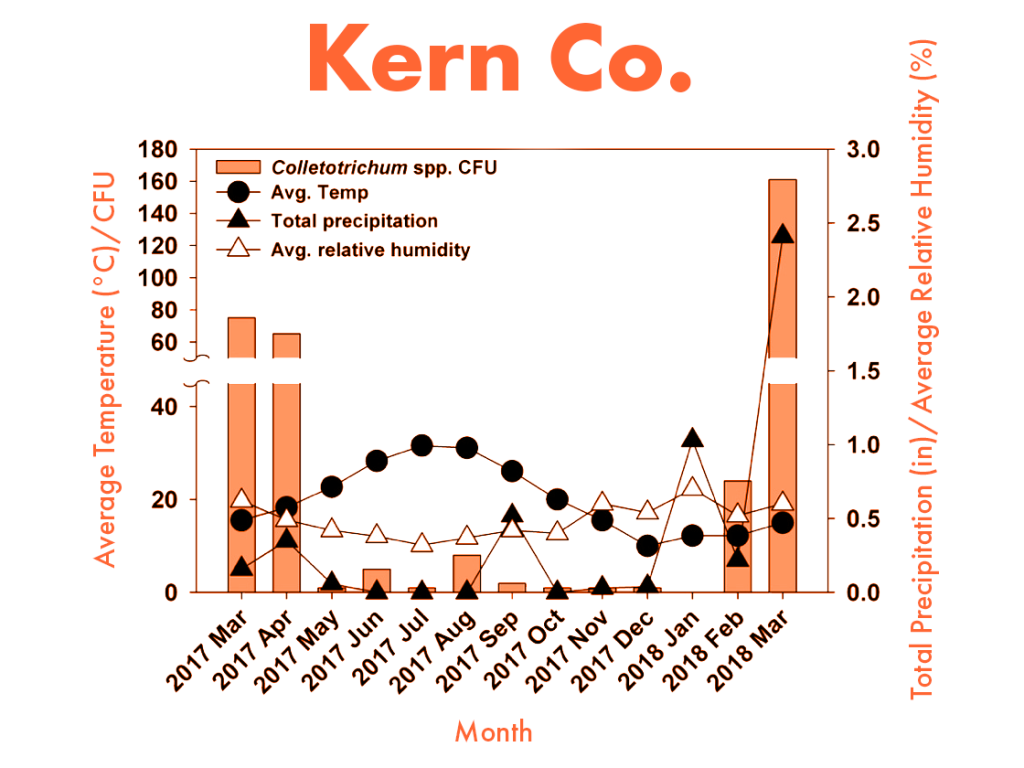
Although little is known regarding the epidemiology of C. karstii on citrus, several environmental factors are likely important for the dissemination and progression of this disease. Relative humidity and precipitation in citrus orchards in California play an important role in the epidemiology of Colletotrichum infection whereby conidia dispersed by rain and humidity are conducive to pathogen spread. Our spore trap study showed that spore trapping of Colletotrichum species occurred most frequently during the months with the highest precipitation (Figure 3), however Colletotrichum spp. were not always correlated with rainfall. Similar results were found with other spore trap studies in California. Wounding is also known to predispose plants to infection by Colletotrichum and typical agricultural practices and the environment in California citrus groves (pruning, shearing, wind/sand damage) give both of these species the opportunity to colonize citrus trees. Based on recent research, symptoms were observed during the late spring and summer months, with no new symptoms being observed into fall, winter and early spring. This suggests that young, tender tissues developing in the late spring are likely necessary for initial pathogen colonization.
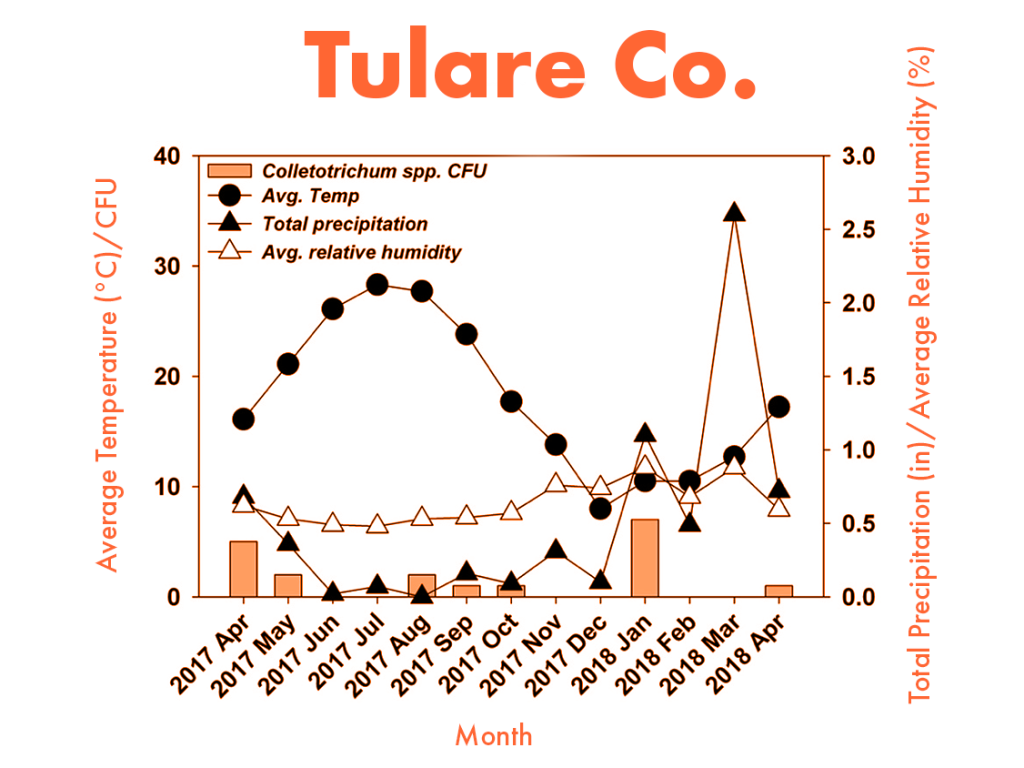
Management Practices for Colletotrichum Dieback
Currently no strategies exist for the management of this emerging disease in citrus. Adherence to cultural practices recommended for the management of other canker and dieback pathogens should be followed. These practices include maintaining trees in good condition through appropriate irrigation regimens and proper fertilization, removal of infested branches and pruning debris during dry periods followed by immediate disposal of infested material, and sanitizing pruning equipment. Chemical management using fungicides is being investigated and these methods may become part of an integrated pest management strategy for Colletotrichum diseases of citrus in California.
Acknowledgements
Financial support for this project was provided by the Citrus Research Board (Project # 5400-152). Plants used for pathogenicity tests were kindly donated by Wonderful Citrus. We thank D. Trannam, R. Yuan, K. Sugino, Q. Douhan, and our cooperating citrus growers for assistance in the lab and field.












